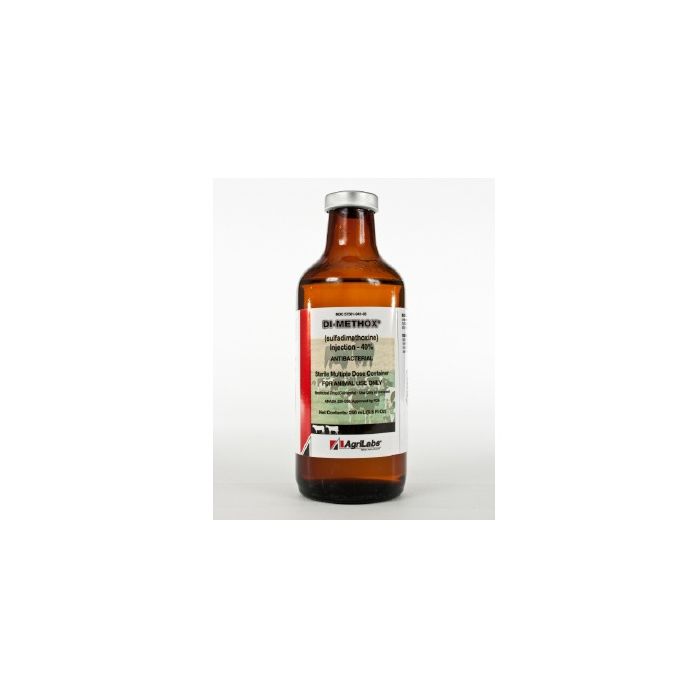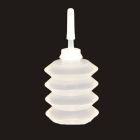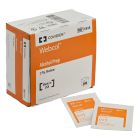Sulfadimethoxine Injection 40% [250 mL]
Sulfadimethoxine Injection 40% [250 mL]
SulfaMed Injection for the treatment of bovine respiratory disease complex (shipping fever complex) and bacterial pneumonia associated with Pasteurella spp. sensitive to sulfadimethoxine; necrotic pododermatitis (foot rot) and calf diphtheria caused by Fusobacterium necrophorum sensitive to sulfadimethoxine. In cattle, Sulfadimethoxine Injection 40% is an effective treatment of bacterial pneumonia, shipping fever complex, calf diphtheria, and foot rot. Sulfadimethoxine has been demonstrated clinically or in the laboratory to be effective against a variety of organisms, such as streptococci, klebsiella, proteus, shigella, staphylococci, E. coli, salmonella and fusobacterium.
Directions
SulfaMed Injection 40% must be administered only by the intravenous route in cattle. Cattle should receive 1 mL of SulfaMed Injection 40% per 16 lb of body weight (55 mg/kg) as an initial dose, followed by 0.5 mL per 16 lb of body weight (27.5 mg/kg) every 24 hours thereafter. Sulfadimethoxine Boluses may be utilized for maintenance therapy in cattle.
Directions for intravenous injection:
Equipment needed:
- A nose lead and/or halter sufficiently strong enough to effectively restrain or hold the animal’s head steady so that the intravenous injection can be made with ease.
- Hypodermic needles, 16 or 18 gauge and 2 inches long. Only new, sharp and sterile hypodermic needles should be used. Dull needles should be discarded. Extra needles should always be available in case the needle being used should become clogged.
- Hypodermic syringes, 40- or 50-mL sterile, disposable or reusable glass syringes should be available.
- Alcohol (70%) or equally effective antiseptic for disinfecting the skin.
Preparation of equipment: Glass syringes and regular hypodermic needles should be thoroughly cleaned and washed. Following this, the needles and syringes should be immersed in boiling water for 30 minutes prior to each injection.
Regular hypodermic needles should not be used more than 3-4 times as repeated skin puncturing and boiling of the needles causes them to become quite dull. Disposable hypodermic needles and syringes should not be used more than once.
Restraint of animal: The cow should preferably be in a stanchion for maximum restraint. If this is not possible, the animal should be restrained in a manner to prevent excessive movement. A nose lead should be applied and the animal’s head turned sidewise to stretch the skin and tense the muscles of the neck region.
Locating the jugular vein: Once the animal has been restrained (as above), you will notice a long depression of the skin from below the angle of the jaw to just above the shoulder. This is known as the jugular furrow or jugular groove. The jugular vein is located just under the jugular groove.
Preparation of SulfaMed Injection 40% for injection: The rubber cap of the bottle should be thoroughly cleaned with 70% alcohol or other satisfactory antiseptic. The correct amount of SulfaMed Injection 40% for treatment should be calculated (see dosage directions) and that amount withdrawn into a syringe. One or two syringefuls of air should be injected into the bottle first to make withdrawing the drug easier. SulfaMed Injection 40% should preferably be at room temperature when filling syringes and when injecting intravenously.
Entering the vein: The skin of the injection area should be clean and free of dirt. Cotton saturated with 70% alcohol (or suitable antiseptic) should be used to wipe the injection site.
Apply pressure over the jugular vein close to the shoulder. This will reduce the flow of blood to the heart and cause the jugular vein to bulge or enlarge. When the jugular vein has been "raised", insert the hypodermic needle at a 45° angle through the skin just underneath the jugular vein. The beveled edge of the hypodermic needle should be up.
After the skin has been punctured, the point of the needle should be directed toward the side of the vein and pushed into the center of the vein. When the needle is in the center of the vein, there will be free flow of blood back through the needle. Release external pressure when you are sure the needle is within the vein.
After the needle has been accurately inserted into the jugular vein, firmly attach the syringe containing SulfaMed Injection 40% to the inserted hypodermic needle. Caution; be sure syringe is free of air. Exert firm pressure on the plunger of the syringe to inject the SulfaMed Injection 40% while the barrel is held firmly.
The injection should be made moderately slow - never rapidly. If the animal moves, causing resistance in pushing the plunger of the syringe, or if a bubble of the drug is noted under the skin, the needle is no longer within the vein. The needle should be repositioned.
When the injection is completed, quickly withdraw the syringe and needle with a quick pull and apply light pressure over the injection site with alcohol and cotton to minimize bleeding from the puncture site.
Sulfadimethoxine Injection 40% [250 mL] Highlights:
- SKU: 13131
- Manufacturer: Durvet
- The skin of the injection area should be clean and free of dirt.
- Apply pressure over the jugular vein close to the shoulder.
- The cow should preferably be in a stanchion for maximum restraint.
- Approved for lactating dairy cows, beef cattle, and ruminating calves
- Sulfadimethoxine Boluses may be utilized for maintenance therapy in cattle.
- SulfaMed Injection 40% must be administered only by the intravenous route in cattle.
- Exert firm pressure on the plunger of the syringe to inject the SulfaMed Injection 40% while the barrel is held firmly.
| SKU | 13131 |
|---|---|
| Manufacturer | Durvet |
| Volume (ML) | 250 ML |
| ORMD | No |
| Hazardous | No |
| Unit of Measure | each |
| UPC | 35756100924 |
| Product Label | Click Here |
| Milk Withhold (Hours) | 60 |
| SDS | Click Here |


![Air Tite Syringe w/ Needle [5 mL] (100 Count)](https://www.armoranimalhealth.com/media/catalog/product/cache/21943d17d76cdf99550cdd2c82aaa778/a/i/air_tite_syringe_w_needle_5_ml_100_count_.jpg)

![Allflex Bottle Mount Syringe [2 mL]](https://www.armoranimalhealth.com/media/catalog/product/cache/21943d17d76cdf99550cdd2c82aaa778/a/l/allflex_syringe.jpg)
![Luer Lock Syringe Air Tite [10 CC] (100 Count)](https://www.armoranimalhealth.com/media/catalog/product/cache/21943d17d76cdf99550cdd2c82aaa778/l/u/luer_lock_syringe_air_tite.jpg)
